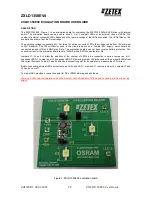
Easy
PIC
for dsPIC30
®
v7
page 22
LD8
LD7
LD6
LD5
LD4
LD3
LD2
LD1
RN8
10K
RN7
10K
RN6
10K
RN5
10K
RN4
10K
RN3
10K
RN2
10K
RN1
10K
T8
T7
T6
T5
T4
T3
T2
T1
R
B
0
R
B
1
R
B
2
R
B
3
R
B
4
R
B
5
R
B
6
R
B
7
R
B
0
R
B
1
R
B
2
R
B
3
R
B
4
R
B
5
R
B
6
R
B
7
PORTB LEVEL
PORTB LED
SW1
1 2 3 4 5 6 7 8
+
_
VCC-BRD
VCC-BRD
VCC-BRD
R
B
0
R
B
1
R
B
2
R
B
3
R
B
4
R
B
5
R
B
6
R
B
7
RB0
RB1
RB2
RB3
RB4
RB5
RB6
RB7
RB0
RB1
RB2
RB3
RB4
RB5
RB6
RB7
UP
DOWN
PULL
CN3
CN4
1
2
3
4
5
6
7
8
9
10
CN5
RB0
RB1
RB2
RB3
RB4
RB5
RB6
RB7
VCC-BRD
SW7
1 2 3 4 5 6 7 8
+
_
VCC
GND
BUTTON PRESS LEVEL
R7 220
VCC-BRD
R6 220
J6
J5
1
2
3
4
5
6
7
8
O
N
SW10
DATA BUS
4K7
One of the most distinctive features of EasyPIC
™
v7
for dsPIC30
®
are it’s Input/Output PORT groups. They
add so much to the connectivity potential of the board.
Everything is grouped together
PORT headers, PORT buttons and PORT LEDs are next to each other, and
grouped together. It makes development easier, and the entire EasyPIC
™
v7 for
dsPIC30
®
cleaner and well organized. We have also provided an additional PORT
headers on the left side of the board, so you can access any pin you want from both
sides of the board.
Tri-state pull-up/down DIP switches
Tri-state DIP switches, like SW1 on Figure 10-2, are used
to enable 4K7 pull-up or pull-down resistor on any desired port
pin. Each of those switches has three states:
1. middle position disables both
pull-up and pull-down feature from
the PORT pin
2. up position connects the resistor
in pull-up state to the selected pin
3. down position connects the
resistor in pull-down state to the
selected PORT pin.
Figure 10-1: I/O group contains PORT headers, tri-state pull
up/down DIP switch, buttons and LEDs all in one place
connectivity
Figure 10-4: Schematic of the single I/O group connected to microcontroller PORTB
Figure 10-3: Button
press level tri-state
DIP switch is used to
determine which logic
level will be applied to
port pins when buttons
are pressed
Input/Output Group
Figure 10-2: Tri-state
DIP switch on PORTB
















































